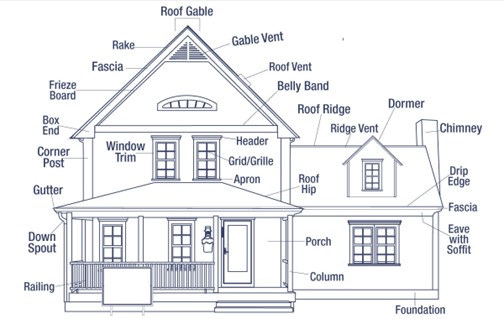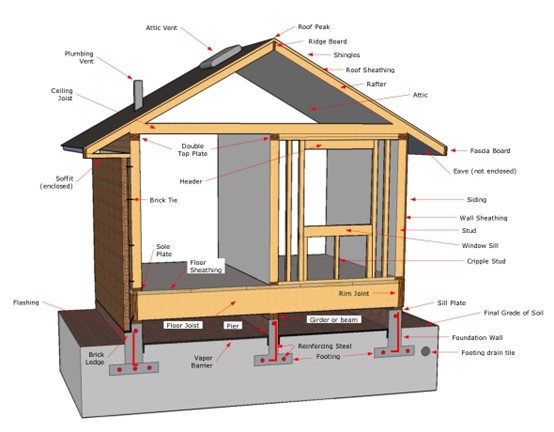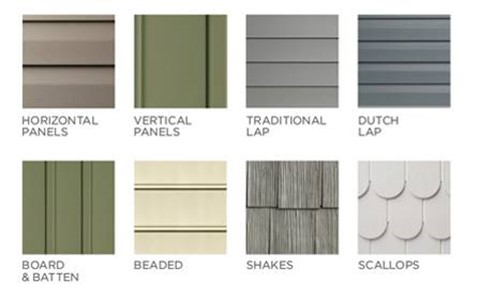Everybody in the market for a new home, from the 1st time home buyer to the experienced, can benefit from knowing a home’s basic “anatomy.” For example, what is a gable? Fascia? Rake? What is a rafter? Band board? Maybe you don’t care. But caring protects you!
Why? Well, it is important to know if the home is in good condition, right? Or if it is in bad condition. And, many real estate agents do not know these things, so you should!
Your Realtor is going to provide comparables (“comps”) that reflect the sale price of other homes in the neighborhood. If the home is in good condition, you can feel confident that the price is right. Are those homes well-cared for? Did the price of those homes reflect maintenance that was done, or should be done? What should you look for, and where?

Do those homes have rotting wood? Hint: Wood is a straw – it is ALWAYS soaking up water, even after it is no longer a tree. There are very few places, unless the home is trimmed with plastic trim, that are not susceptible to rot. In the drawing only the Gable Vent, Chimney, Foundation, Drip Edge, Gutters and Downspouts are made of materials that will not rot.
Does the home you are searching for have rotting wood? It just might. So you ought to know what to look for! When you get a home inspection, your inspector will discuss the severity of any issues, and you will know what he is talking about! You will have an easier time determining whether the home is worth making yours. Later, when you talk to a contractor about any repairs, you will be protected from the fake expert at the very least! Imagine this conversation – “Hey, I’ve got some rotting wood at the right side fascia board. Can you come estimate the cost and reapir it?” When the contractor knows you know what you are doing, he is not going to over-charge you – or if he tries, you can confidently hire someone else.
Here is a bit more house anatomy detail:

Start with the exterior and look for roof damage and rotting wood. Remember, everything can be fixed! It was built; therefore, it can be replaced. You do have to see the home live – when using a real estate search portal (Real estate website), please understand that photographers are not going to take pics of damaged goods – they are quite good at avoiding such flaws – the home seller and listing agent often insist!
Knowing a anatomy is deeper than the trim. Shingles, flashing, roof sheathing, and windows all have aspects a smart home buyer will look for.
- Are there any missing or damaged shingles?
- Is the existing roof one layer or more than one?
- Are the shingles 3-tab, or architectural?
- Are they worn, or covered with moss?
- Do you see any suspected soft spots?

Answers to these questions allow you to determine if the roof the roof needs to be replaced.
Siding matters also. And, there are several types of siding:
- Brick and Stone are great, because of their durability. However, is the mortar (the seams between the bricks) solid? Repointing (repairing the mortar) brick is expensive. Replacing brick with matching is almost impossible, but brick can be painted if you must replace it and cannot get matching.
- Wood siding, particularly cedar, is found on many older houses, and some new (in expensive neighborhoods). It is easily matched (typically it is straight, clapboard style planks). It can be stained or painted. It does rot, so maintenance cost is key when deciding on this option.
- Fiber cement has been around for over 100 years and is still in use today. However, in older houses it had asbestos in it. That does not mean you should run. Asbestos is only bad if you grind it up and inhale it. It can be safely removed if necessary (like if it is heavily damaged). This siding can be painted and is quite durable. Again, older installations will be difficult, if not impossible, to match.
- Aluminum siding was popular in the 70’s and 80’s, and is still available today, though rare in some areas of the U.S. Like other siding, it is hard to find matching aluminum, if you can find it at all. It dents, fades, and looks industrial.
- Vinyl siding is everywhere these days. It has been used as the least cost option for replacing siding for decades. It comes in many styles and colors. It is easier to match, though every manufacturer, it seems, has their own profile, making it best to try and find out who made the siding product.
The list above is not all-inclusive, but you can see that siding is not a simple proposition, and it is essential that it be addressed.

Is there a deck? Are there warped boards, or does it shake when you walk on it? Many decks can be power washed and look as good as new, but you need to replace anything that is not straight. Staining is an option to restore a decent look to a deck. Sometimes it has to go – if it doesn’t meet building code (often the case when the homeowner built it, often without a permit).
Even masonry can have issues. Look at the chimney. Does it have chimney caps (metal top and mesh to keep water and animals out)? Is the mortar solid? Repointing/repairing a chimney can cost thousands, and a buyer’s home inspector is going to do everything but stick a camera down into it.
Check out the sidewalk, and the driveway. Look for cracks, or areas where the concrete is uneven. Fixing a driveway is essential if you have areas where water pools – you do not want to give it a chance to get into the house.
Finally, Mechanical, Electrical, and Plumbing are repairs that could be costly, so educate yourself on these systems.
Mechanical
Also called HVAC (Heating, Ventilation, Air Conditioning), this is potentially a big expense.
Is the heating fuel oil, gas, or electricity? An HVAC system lasts 20-30 years depending on how well it has been maintained. The age of the unit is buried in the serial number, but frequently the first 2 numbers are the week it was built, the second two are the year. As a home buyer, the LAST thing you want to do is replace an HVAC system right after you just emptied a bank account buying your home. If the unit is filthy, rusting, or noisy, replacement may be the best choice but will cost up to $10,000, perhaps more depending on the size.
The top of the unit is the A/C, often called the “A” frame. It is always electric. Finally, remember that anything with moving parts, and an HAVC unit does have moving parts, is going to break!
Electrical
Sometimes, you cannot tell if the electrical system is adequate. Your home inspector is better at this than you will ever be. Check for a few things though – Outlets should be GFCI (ground fault circuit interrupter) if they are near water, like near the kitchen sink. Bathrooms should have proper GFCI outlets as well.
Plumbing
Homes have cast iron, copper pipes, PVC (drainage), CPVC (supply), and Pex pipes these days. Cast irin is older, and should not be rusty or leaking. When looking at copper pipes, look for potential pin-hole leaks – greenish corrosion at joints, or even in the middle of the pipe run itself.
Under each sink is the S-shaped pipe called a “trap.” Traps are made of PVC pipe. These are designed to keep sewer gases in (bathtubs have traps underneath as well). These should be free of leaks.
Finally supply lines are made of CPVC (off-white in color) and Pex. CPVC can be brittle in older homes. Pex is used in newer homes by many plumbers these days. One more thing about supply lines – in the late 80’s, plumbers used a material called polybutylene. The joints were quite susceptible to cracking under pressure. While you should not run away if you like the home, make the seller replace these pipes. You will be happy that you did.
Alejandro Ringler
